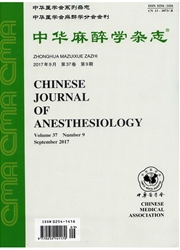

 中文摘要:
中文摘要:
目的评价P2X3受体在大鼠神经病理性痛形成和维持中的作用及其与背根神经节NF-κB的关系。方法鞘内置管成功的SPF级健康雄性SD大鼠36只,体重180~200 g,4~6周龄,采用随机数字表法分为3组(n=12):假手术组(S组)、神经病理性痛组(NP组)和P2X3受体拮抗剂A-317491组(A组);鞘内置管成功后第3天,采用坐骨神经缩窄性损伤法制备大鼠神经病理性痛模型;S组只游离坐骨神经不做损伤处理。术后1 d开始连续鞘内注射,连续14 d(2次/d):S组与NP组分别鞘内注射生理盐水20 μl,A组鞘内注射A-317491 100 nmol/10 μl+生理盐水10 μl,分别于术前1 d、术后1、3、7、10和14 d鞘内给药后30 min时测定热痛阈和机械痛阈。分别在术后7和14 d时处死大鼠,取脊髓背根神经节,采用Western blot法检测P2X3受体和NF-κB p65的表达。结果与S组比较,NP组术后各时点热痛阈和机械痛阈降低,术后7和14 d时背根神经节P2X3受体和NF-κB p65表达上调(P〈0.05或0.01);与NP组比较,A组术后各时点热痛阈升高,术后3、7、10和14 d时机械痛阈升高,术后7和14 d时背根神经节P2X3受体和NF-κB p65表达下调(P〈0.05)。结论大鼠神经病理性痛形成与维持的机制与背根神经节P2X3受体表达上调,促进NF-κB表达有关。
 英文摘要:
英文摘要:
Objective To evaluate the role of P2X3 receptors in the development and maintenance of neuropathic pain(NP)and the relationship with nuclear factor kappa B(NF-κB)in dorsal root ganglia of rats.Methods Thirty-six SPF healthy male Sprague-Dawley rats, weighing 180-200 g, aged 4-6 weeks, in which intrathecal catheters were successfully implanted, were divided into 3 groups(n=12 each)using a random number table: sham operation group(group S), NP group and P2X3 receptor antagonist A-317491 group(group A). At 3 days after intrathecal catheters were successfully implanted, NP was induced by chronic constriction injury to the sciatic nerve.The sciatic nerve was only exposed but not occluded in group S. Intrathecal injection was performed twice a day for 14 consecutive days starting from 1 day after operation.Normal saline 20 μl was intrathecally injected in group S and group NP, and A-317491 100 nmol/10 μl and normal saline 10 μl were intrathecally injected in group A. Thermal paw withdrawal threshold(TWT)and mechanical paw withdrawal threshold(MWT)were measured on day 1 before operation and at 30 min after intrathecal injection on days 1, 3, 7, 10 and 14 after operation.On days 7 and 14 after operation, the rats were sacrificed and the dorsal root ganglia of the lumbar segment were removed for determination of the expression of P2X3 receptors and NF-κB p65 by Western blot.Results Compared with group S, TWT and MWT were significantly decreased at each time point after operation, and the expression of P2X3 receptors and NF-κB p65 in dorsal root ganglia was up-regulated on days 7 and 14 after operation in group NP(P〈0.05 or 0.01). Compared with group NP, TWT was significantly increased at each time point after operation, MWT was increased on days 3, 7, 10 and 14 after operation, and the expression of P2X3 receptors and NF-κB p65 in dorsal root ganglia was down-regulated on days 7 and 14 after operation in group A(P〈0.05).Conclusion The mechanism underlying the development an
 同期刊论文项目
同期刊论文项目
 同项目期刊论文
同项目期刊论文
 期刊信息
期刊信息
